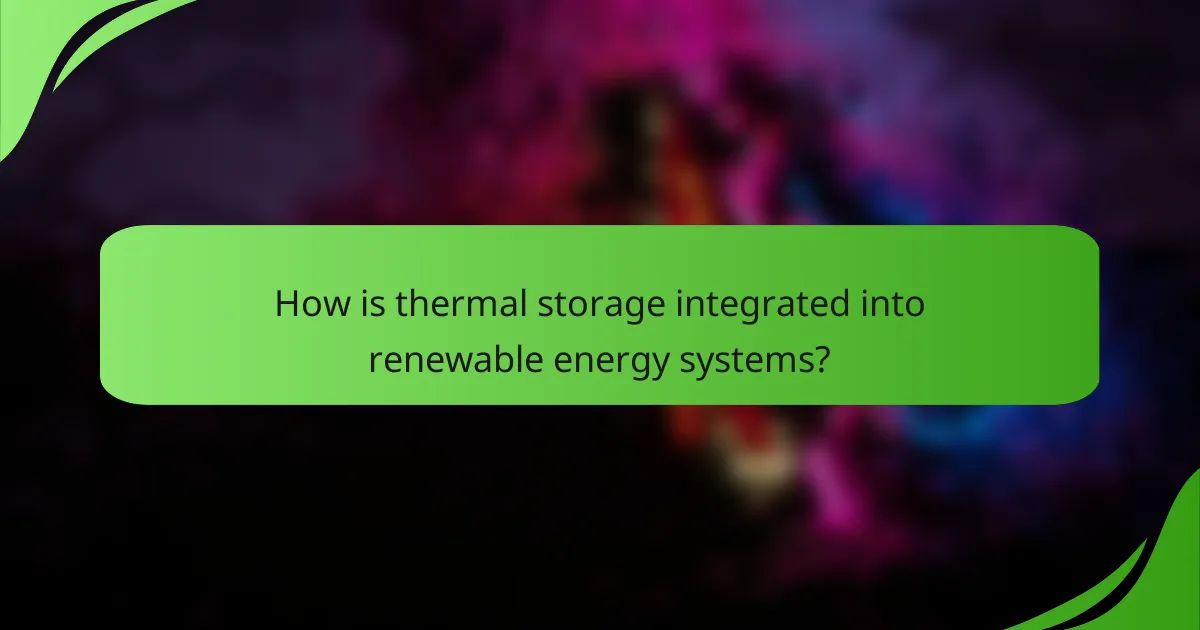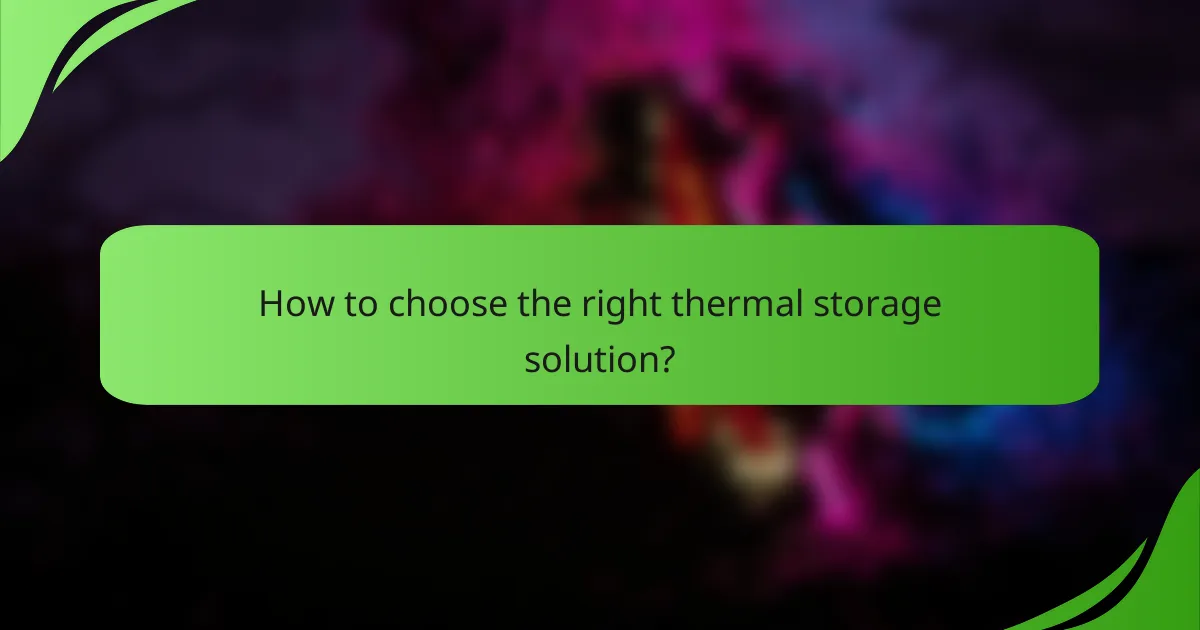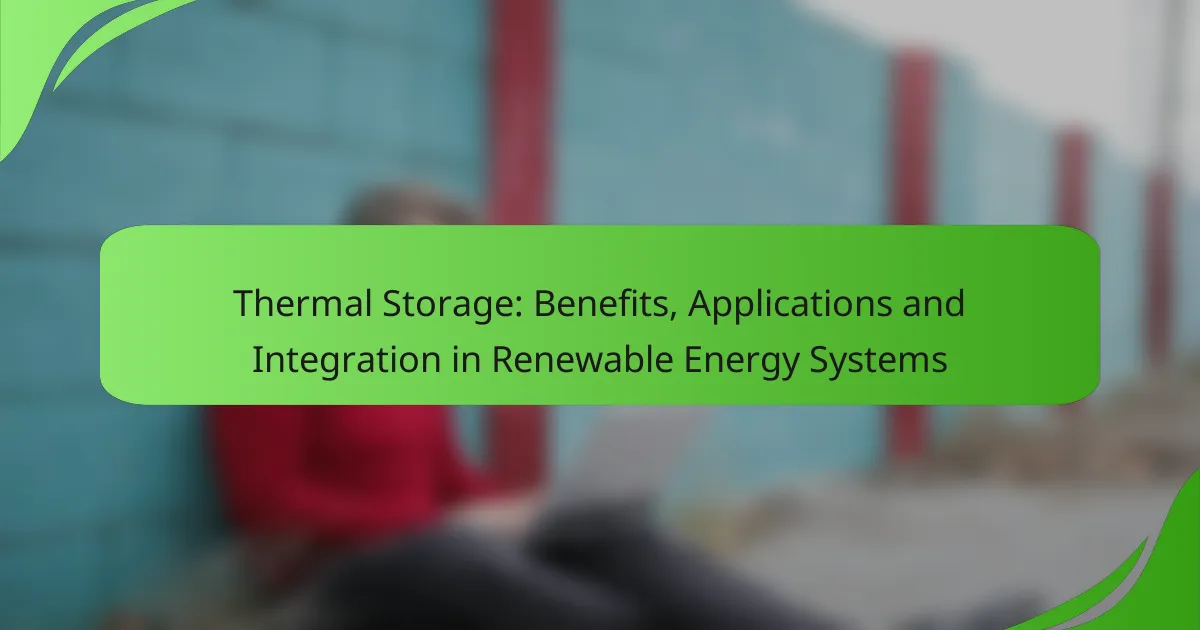Thermal storage plays a crucial role in enhancing the efficiency and reliability of renewable energy systems by capturing excess thermal energy during peak production periods. This stored heat can be released when demand is high, helping to balance supply and demand fluctuations. By integrating various thermal storage technologies, such as molten salt and phase change materials, these systems contribute to a more sustainable and stable energy landscape.

What are the benefits of thermal storage in renewable energy systems?
Thermal storage in renewable energy systems offers several advantages, including improved energy efficiency, cost savings, and enhanced grid stability. By storing excess energy in the form of heat, these systems can better manage supply and demand fluctuations, ultimately leading to a more sustainable energy landscape.
Increased energy efficiency
Thermal storage enhances energy efficiency by allowing renewable energy sources, such as solar and wind, to operate at their maximum potential. By storing energy during peak production times and releasing it during high demand, thermal storage systems reduce the need for backup fossil fuel generation.
For example, a solar thermal plant can store heat in molten salt, enabling it to generate electricity even when the sun isn’t shining. This capability can lead to overall system efficiencies exceeding 90% in optimal conditions.
Cost savings on energy bills
Implementing thermal storage can lead to significant cost savings on energy bills. By shifting energy consumption to off-peak hours when electricity rates are lower, users can take advantage of time-of-use pricing structures.
In some regions, businesses have reported reductions in energy costs by up to 30% by utilizing thermal storage systems. This is particularly beneficial in areas with high demand charges, as thermal storage can help flatten peak usage profiles.
Enhanced grid stability
Thermal storage contributes to enhanced grid stability by providing a buffer against fluctuations in energy supply and demand. By storing energy, these systems can help balance the grid during periods of high demand or when renewable generation is low.
For instance, during a sudden drop in wind energy production, thermal storage can quickly release stored heat to maintain grid reliability, reducing the risk of blackouts and ensuring a steady supply of electricity.
Reduction of carbon emissions
By integrating thermal storage with renewable energy systems, carbon emissions can be significantly reduced. These systems decrease reliance on fossil fuels, which are major contributors to greenhouse gas emissions.
In many cases, thermal storage allows for a higher penetration of renewables in the energy mix, leading to cleaner energy generation. For example, a combined solar and thermal storage system can reduce emissions by several tons per year compared to traditional fossil fuel power plants.
Improved energy access
Thermal storage can improve energy access, particularly in remote or underserved areas. By providing a reliable energy source, these systems can support local communities and industries that may lack consistent electricity supply.
In developing regions, thermal storage can be integrated with solar technologies to provide affordable and stable energy solutions, enhancing economic opportunities and improving quality of life for residents.

How is thermal storage integrated into renewable energy systems?
Thermal storage is integrated into renewable energy systems by capturing excess thermal energy generated during peak production times and releasing it when demand is higher. This process enhances the reliability and efficiency of renewable sources like solar and wind energy, allowing for better energy management and grid stability.
Integration with solar power systems
In solar power systems, thermal storage typically involves using materials like water, molten salts, or phase change materials to store heat generated during sunny periods. This stored heat can then be used to produce steam for electricity generation or for direct heating applications when sunlight is not available.
Common configurations include concentrated solar power (CSP) plants that utilize large thermal storage tanks, enabling energy production even during cloudy days or at night. This capability can significantly improve the overall efficiency of solar energy systems.
Integration with wind energy systems
For wind energy systems, thermal storage can complement electricity generation by storing excess energy as heat during high wind periods. This stored energy can be converted back to electricity or used for heating when wind speeds drop, ensuring a consistent energy supply.
Hybrid systems that combine wind turbines with thermal storage can enhance grid stability and reduce reliance on fossil fuels. However, the integration requires careful planning to balance energy production and storage capacity.
Use in district heating applications
Thermal storage is widely used in district heating systems, where it helps manage the supply of heat to multiple buildings. By storing heat generated from renewable sources or waste heat, these systems can provide consistent heating even during peak demand times.
In many European cities, thermal storage tanks are strategically placed to optimize energy distribution and reduce costs. This approach not only increases efficiency but also supports the transition to more sustainable energy sources, aligning with regional energy policies.

What types of thermal storage technologies are available?
Various thermal storage technologies are designed to store heat for later use, enhancing energy efficiency and integrating with renewable energy systems. The most common types include molten salt storage, ice storage systems, phase change materials, and water tank storage.
Molten salt storage
Molten salt storage systems utilize a mixture of sodium nitrate and potassium nitrate to store thermal energy at high temperatures, typically between 250°C and 600°C. This technology is often used in concentrated solar power (CSP) plants, allowing for energy generation even when sunlight is not available.
Key considerations include the high thermal efficiency and long discharge times, which can range from several hours to a full day. However, initial setup costs can be significant, making it essential to evaluate the economic feasibility based on local energy prices.
Ice storage systems
Ice storage systems create ice during off-peak hours and use it to cool buildings during peak demand periods. This method can significantly reduce electricity costs by shifting energy use to times when rates are lower.
These systems typically operate at temperatures around 0°C and can provide cooling for several hours. They are particularly beneficial in commercial settings, where cooling demand is high during the day. However, proper sizing and maintenance are crucial to ensure optimal performance.
Phase change materials
Phase change materials (PCMs) store and release thermal energy during phase transitions, such as from solid to liquid. They can be integrated into building materials or used in dedicated storage systems, providing efficient temperature regulation.
PCMs can operate in various temperature ranges, depending on the material used, and are effective for both heating and cooling applications. Their compact nature allows for easy integration into existing structures, but careful selection of the PCM is necessary to match the specific thermal requirements of the application.
Water tank storage
Water tank storage is one of the simplest and most widely used thermal storage methods. It involves heating water in a tank and using it for heating or cooling as needed. This method is often employed in residential and commercial heating systems.
Water tanks can store thermal energy at temperatures typically between 40°C and 90°C. They are relatively low-cost and easy to maintain, but their effectiveness can be limited by the tank size and insulation quality. Regular monitoring is recommended to ensure optimal performance and efficiency.

What are the applications of thermal storage in major cities?
Thermal storage plays a crucial role in major cities by enabling efficient energy management across various sectors. Its applications range from urban heating solutions to industrial energy management and residential energy storage, helping to balance supply and demand while integrating renewable energy sources.
Urban heating solutions
In urban environments, thermal storage systems are often used to provide heating during peak demand periods. These systems store heat generated from renewable sources, such as solar thermal or biomass, and release it when needed, reducing reliance on fossil fuels.
For example, district heating networks in cities like Copenhagen utilize large thermal storage tanks to maintain a steady supply of heat, allowing for better energy efficiency and lower emissions. This approach can significantly decrease heating costs for residents and businesses alike.
Industrial energy management
Industries can leverage thermal storage to optimize energy use and reduce operational costs. By storing excess heat generated during production processes, companies can utilize this energy during high-demand periods, leading to lower energy bills and improved sustainability.
For instance, manufacturing plants can implement molten salt storage systems to capture waste heat, which can then be used for heating or power generation. This not only enhances energy efficiency but also helps companies meet regulatory standards for emissions.
Residential energy storage
In residential settings, thermal storage systems provide homeowners with a way to manage energy consumption effectively. These systems can store heat from solar panels or off-peak electricity, allowing families to use energy when it is most cost-effective.
Homeowners can consider installing hot water tanks or phase change materials to store thermal energy. This can lead to significant savings on energy bills, especially in regions with variable electricity pricing. Additionally, integrating thermal storage with home automation systems can further enhance energy management and comfort.

How to choose the right thermal storage solution?
Choosing the right thermal storage solution involves assessing your specific energy needs and evaluating the cost-effectiveness of different options. Factors such as the type of energy system, intended application, and budget will guide your decision-making process.
Assessing energy needs
Start by determining the amount of energy you require for your applications. Consider peak demand times and how much energy can be stored during off-peak hours. For instance, if you are integrating thermal storage with a solar energy system, assess how much energy can be collected during the day and how long it needs to last for nighttime use.
Next, evaluate the temperature requirements of your processes. Different thermal storage solutions, such as molten salt or water tanks, operate efficiently at various temperature ranges. Aligning your energy needs with the appropriate storage technology is crucial for optimal performance.
Evaluating cost-effectiveness
Cost-effectiveness is a key factor when selecting a thermal storage solution. Calculate the initial investment, ongoing maintenance costs, and potential savings on energy bills. Compare different technologies, as some may have higher upfront costs but lower operational expenses over time.
Consider the lifespan of the thermal storage system as well. Systems with longer lifespans may offer better long-term value, even if they require a higher initial investment. Additionally, check for any available incentives or rebates in your region that could offset costs, such as government programs promoting renewable energy integration.
